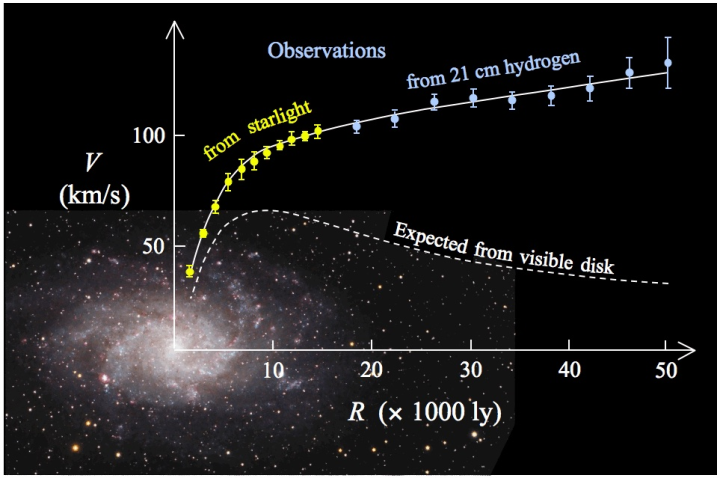
Anyone who’s read one or two of my Long Links curations knows that I’m fascinated by the ongoing conundra in Astrophysics and Cosmology on the subject of Dark Matter. There are a couple of recent developments that are worth noting.
Micro-introduction · Astrophysicists were kind of forced into concluding that Dark Matter exists for several reasons, but the most obvious is that galaxies spin and the stars on the outer edges are orbiting too fast.
Too fast, that is, given two assumptions:
The only force that matters at galactic scale is gravity.
The action of gravity is (classically, not relativistically) described by Isaac Newton’s Greatest Hit:
[Wow, I blasted raw MathML into HTML and it seems to have Just Worked.]
Most experts in the field now believe that galaxies are surrounded by huge halos of Dark Matter; arrange it right and then ol’ Isaac’s formula has the stars moving just the way we observe them. It seems like regular matter is a fifth or less of the total amount of gravitational mass in the universe. Dark Matter usefully explains other things about the structure of the Cosmic Microwave Background and the layout of matter in space generally.
The fact that we can’t see it through telescopes or with particle detectors probably means it must be a new form of matter. Which makes physicists’ eyes light up, and they’ve been trying to detect the stuff for decades. And failing, and failing, and failing. They’ve had multiple perfectly reasonable theories for what kind of particles might make up Dark Matter and devised insanely clever experiments to catch them, but no luck.
Eventually someone said, “Uh, about those assumptions…” In particular the second, which is that Newton’s law applies universally, both in the relatively matter-dense neighborhood that I and you, Dear Reader, inhabit, and out in the millions-of-times-less-crowded space at galaxies’ edges.
Thus, Modified Newtonian Dynamics (“MOND” for short). That Wikipedia link has a nice little introduction and the math in the overview isn’t too scary. It introduces a new fundamental constant a0, the (very, very low) level of acceleration where gravity maybe starts to act differently.
MOND isn’t an actual physical theory, it’s just a hypothesis that predicts the observed behavior of most galaxies very nicely without the help of Dark Matter. As noted above, most physicists still think the Dark Matter is out there, we just haven’t figured out how to detect it. But not all physicists.

What’s new? · Two things. First, there’s a new book giving an overview of the problem: The Elephant in the Universe: Our Hundred-Year Search for Dark Matter, by Govert Schilling, who seems an accomplished science writer. It was given a mostly-positive review in the WSJ by Katie Mack, one of my heroes, so of course I bought it. [Warning: If you follow that link and buy it too, not only will you be sending money to Amazon, I get a cut too.]
It’s a big subject but it’s not a big book; I plowed through it in a single evening. He introduces you to the people leading the Dark-Matter charge and they’re interesting people. It’s even got pictures, and he keeps the math under control. I don’t pretend to deep understanding of Real Astrophysics Math but the author did a good job (in my opinion as the holder of a little-used decades-old math degree) of giving the essential flavors of the problem.
Amusingly, his chapter on the folk interested in MOND is entitled “The Heretics”.
LUX-ZEPLIN · This is currently the largest and most advanced working dark-matter detection experiment, situated in an old mine a little over a mile under the soil of South Dakota. It has just been spun up and the results of its first sixty days’ real science were released on July 7 as a published paper and a presentation: slides and video.
At the center of the detector is seven tonnes of liquid xenon, surrounded by really a whole lot of other stuff. The flavor of Dark Matter they’re looking for consists of Weakly Interacting Massive Particles, which physicists call WIMPs. (Another theorized but not observed flavor of Dark Matter particles is referred to as MACHOs, for Massive Compact Halo Objects.)
Inside the LZ detector. The real action is in the white central cylinder behind the enclosing transparent one.
I watched the video on YouTube and enjoyed it immensely. The detector is an absolutely fabulous construct, full of raw steampunk beauty, and their description of the problems they’ve had to solve to get the thing to work was absolutely compelling.
So, did they find any WIMPs? They did not, in sixty days’ worth of data. But they plan to run for thousands, and then we’ll see. As with previous Dark-Matter-hunting experiments, they did lower the ceiling on the hypothetical WIMP’s cross section to 6x10-48 cm2. There are two other experiments of a comparable scale spinning up, and the research groups have already got together, decided they need a still-bigger detector, and founded the XLZD consortium to drive that.
Will they find their WIMP? · Nobody knows; that’s the point. But they’re routing millions and millions in research funding at the problem, and literally thousands of researcher-years of effort.
The people who find MOND interesting are dubious. One example would be Stacy McGaugh, a professor at Case Western University, who has a well-constructed and highly readable blog called Triton Station. He discusses the LUX-ZEPLN results in LZ: another non-detection.
He is polite but fairly cutting: “As remarkable a technological accomplishment as experiments like LZ are, they are becoming the definition of insanity: repeating the same action but expecting a different result.”
For their part, the (large majority) who think the Dark Matter is out there and we just have to measure harder are serenely confident.
Isn’t it fun?
如有侵权请联系:admin#unsafe.sh

